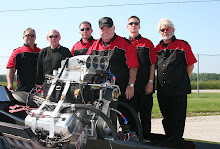Here's some details of what happens from the time we tow the car to the starting line to the end of the run.
We tow up, unhook the car from the truck and position the car beside the truck and lined up with the track.
We have batteries in the back of the truck and we run cable to the starter which mounts to the blower.
When we get a signal from the track official John gives the engine a big squirt of alcohol from a squirt bottle to prime the engine. I begin spinning the engine over with the starter and John signals Corey who pulls a ground wire from the coil which energises the ignition and brings the engine to life. John continues to feed alcohol from the squirt bottle to the engine until the nitro fills the fuel lines and the engine starts running on the nitromethane. I remove the starter from the front of the engine and hand it over to Allen who puts it in the back of the truck. Randy switches the power on to the data recorder.
David rolls the car through the water box and feathers into the throttle and the engine roars as the tires boil with smoke. David lets out of the throttle and brings the car to a smooth halt a few hundred feet down the track. I jog down the track and give David signals as he backs up toward the starting line where John is standing signaling me. We make sure that the car is lined up straight and centered in the rubber he just applied to the track on the burnout.
David stops the car behind the staging beams and John checks the oil pressure and idle speed. He has an adjustment on the hat riser that he can raise or lower the idle to get the idle speed he wants. He then guides David within inches of the first staging beam where he turns the car over to David to proceed staging.
I go around the back of the car and wait for David to light the first staging bulb. At that point I start the data recorder and David pulls a cable which switches the fuel system on the car from low pressure to high pressure. You can see the fuel start billowing from the pipes and the sound of the engine gets really serious. David then lights the second stage bulb and waits for the tree to activate the green light and he is gone!
You can see most of this in the photo sequence below except for the backing up. You can also see that on the run the car does not just drive perfectly straight down the track and that it lays a clean stripe of smooth black rubber down the track. These cars are really a handful to drive and they are always on the edge of spinning the tires. At the end of the sequence you can see a lot of raw fuel coming out of the pipes because the engine went lean around half track and destroyed some of the spark plugs. This caused the car to lose some of its acceleration and David felt it and shuts the car off early around 1000 feet into the run. That also attributed to the relatively slow speed (198mph) for a 6.14 run.
Hopefully this will give some insight into what events take place during a run for those of you who read this blog but have not yet had a chance to see us race in person.
Brad
Wednesday, October 29, 2008
Subscribe to:
Post Comments (Atom)






No comments:
Post a Comment